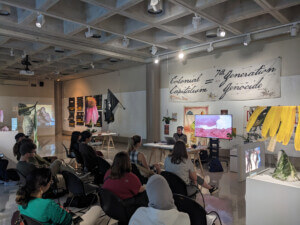The American Institute of Architects’ Los Angeles chapter (AIA|LA) has published an Equity, Diversity, and Inclusivity (EDI) best practices guide that aims to provide a roadmap for how firms of all sizes can begin to transform themselves into more socially just organizations.
The guide is published as a PDF here and can also be acquired in hardcopy from AIA|LA staff.
The double-sided, tri-fold pamphlet is printed on cardstock to be a handy, easy-to-reference guide durable enough to be kept at one’s desk for long-term use, according to AIA|LA executive director Carlo Caccavale, the major force behind the guide.
In terms of its content, the guide is focused on inspiring small but meaningful organizational tweaks that might help usher in an EDI-focused firm culture. To create this resource, Caccavale and AIA|LA executive assistant Kirstin Jensvold-Rumage scoured existing EDI guides published by universities, architecture firms, and other entities in search of a digestible list of incremental policy changes and cultural shifts any architecture firm could undertake.
“The whole idea,” Caccavale explained over telephone, “is to make it easy to read.”
The guide is divided up into six categories and includes a section that covers how to mitigate unintentional and implicit bias in hiring, for example. The backside of the guide is split up based on approaches that can be taken by firms of various sizes.
Some of the measures that can be taken by larger firms include:
- Making an internal commitment to launch a specific role or representative in the firm to address issues of equity, diversity, and inclusion.
- Encouraging 50/50 gender equity by 2020 by promoting gender equity in staff makeup, hiring practices, and project selection.
- Building and embracing alternate workplace models that foster inclusivity like authoring internal anti-discrimination policies and offering flexible hours and telecommuting to reduce employee turnover.
Some suggestions for smaller firms include:
- Sponsoring and participating in programs organized by ethnic or cultural minority groups in the field.
- Participating in EDI trainings hosted by AIA|LA and other approved agencies.
- Ensuring there is diversity and community representation in architectural renderings, imagery, and presentations.
Through the guide, which was instigated, supported, and approved by the AIA|LA board of directors, AIA|LA also emphasizes its own commitment to “walk the walk” by instilling EDI best practices across its own organization. Specifically, AIA|LA has pledged to increase the representation of ethnic and cultural minorities and women in leadership roles in the organization by 1%—7 people—by 2020. By 2030, the organization hopes to increase the number of minority and female AIA|LA members by another 20 individuals, as well. On top of all this, the organization also hopes to have its general membership better reflect the diversity of the City and County of Los Angeles by 2030.
With the guide, AIA|LA is also looking to push how it recognizes and supports cultural diversity and gender parity by folding these objectives into its own advocacy efforts and awards programs.
A few of the planned changes include:
- Advertising the opening of pre-qualification lists for government contracts to small firms (government contracts are often structured to benefit minority- and women-led organizations).
- Infusing the organization’s Presidential Awards policy with EDI values as guidelines for the selection process.
- Organizing college tours of Historic Black Colleges & Universities (HBCUs) to allow firm leaders and hiring teams to see student talent and understand the legitimacy of HBCU architecture programs.
In a press release announcing the guide, AIA|LA President Tania Van Herle said, “The actualization of equity, inclusiveness, and diversity is fundamental to human dignity, leading to opportunity, fully realized careers, and thriving practices.” Van Herle added, “EDI also looks outward—it directly influences our capabilities to serve communities.”
Caccavale explained that more changes are in the works from AIA|LA as well, including a possible new merit award that would highlight minority and female talent along the lines of the AIA’s existing Whitney M. Young, Jr. award, which is presented to firms and individuals that engage in socially-meaningful architectural work.
The unveiling of the EDI guide comes as the chapter has steadily increased its efforts to promote cultural, racial, and gender diversity among the ranks of architects and also precedes a set of new rules added to the national AIA organization’s Code of Ethics that relate to issues of sexual harassment, professionalism, and environmental concerns.
The Los Angeles chapter launched a Women in Architecture Committee in 2016 to “promote positive change for women in the field of architecture” and has held its EDI-focused Encompass conference since 2017 to help “actualize diversity and inclusiveness to advance the profession.”
On September 20, AIA|LA will host the fifth iteration of its POWERFUL event, a symposium to empower women in architecture. The event has grown steadily over the years from a small gathering to a full-on conference packed with panel discussions, keynote speakers, and break-out sessions.
The conference will showcase nearly a dozen speakers, two panel discussions, and 24 lunchtime discussion sessions. Speakers and panelists for the conference include:
- Pooja Bhagat, principal, Poojabhagat Architects + Planners
- Raven Hardison, lead designer, Parsons
- Kerenza Harris, director of design technology, Morphosis Architects
- Rachel Jordan, architect, CO Architects
- Elizabeth Mahlow, founding partner, Nous Engineering
- Elaine Molinar, partner and managing director, Snøhetta
- Lisa Pauli, design director, R&A Architecture + Design
- Anne Schopf, design partner, Mahlum Architects
- Maria Smith, executive creative director, M&C Saatchi
- Elizabeth Timme, co-founder, LA-Más
-
Ingalill Wahlroos-Ritter, dean, Woodbury School of Architecture
-
Deborah Weintraub, chief deputy city engineer, City of Los Angeles
Laura Friedman, assistant speaker pro tempore of the California State Assembly and Assembly Member, District 43/Glendale will be the conference’s keynote speaker.
For more information on EDI goals, POWERFUL, and AIA|LA’s other diversity and inclusion initiatives, see the AIA|LA website.











